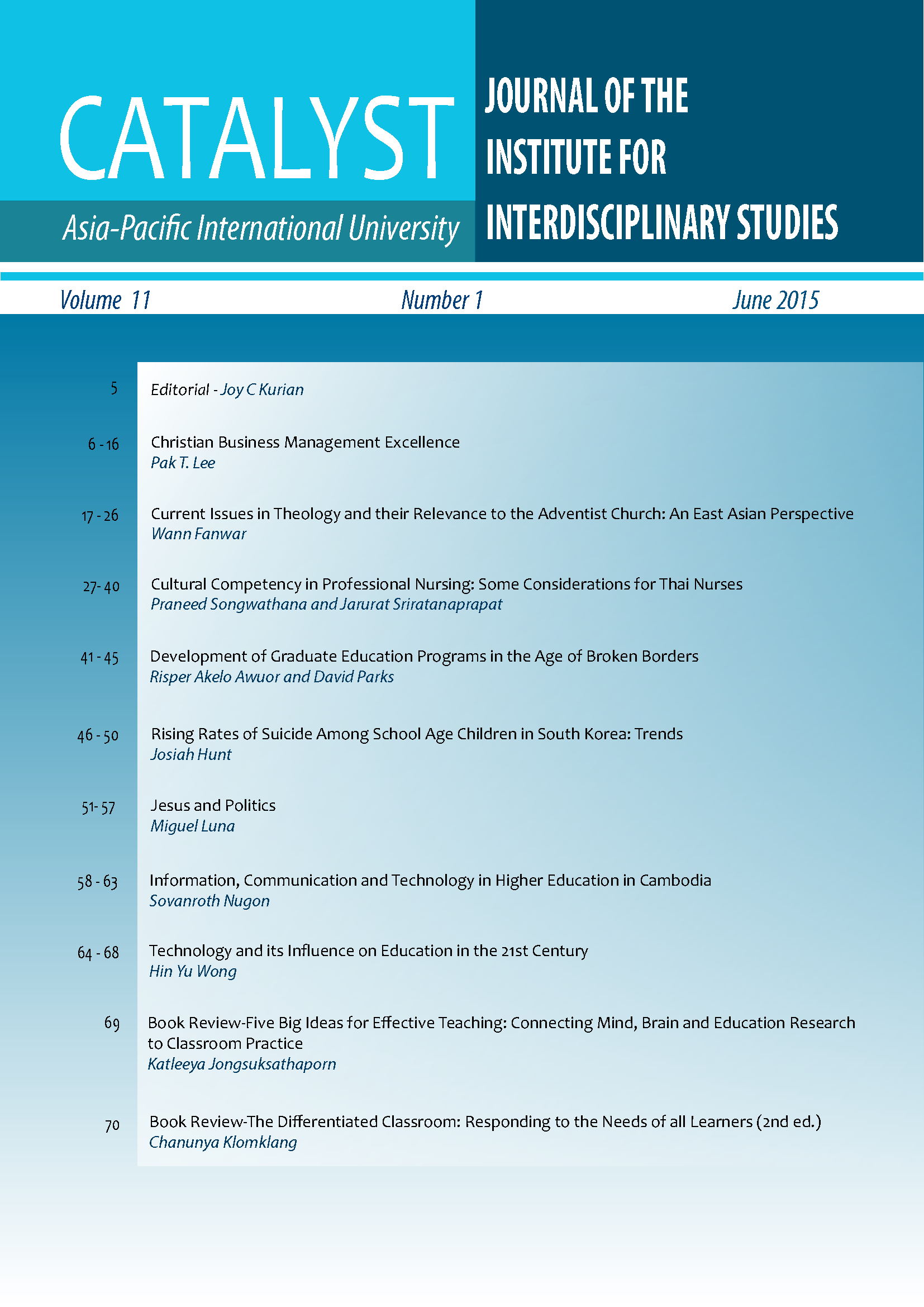Rising Rates of Suicide Among School Age Children in South Korea: Trends
Main Article Content
Abstract
South Korea, a member of the Organization for Economic Cooperation and Development, has experienced unprecedented growth within the last 60 years. Commentators frequently attribute the nations success to its system of education. Though education has indeed contributed much to the advancement of the nation, it has been identified that the hypercompetitive nature of education has led to an exponential increase in suicide among school age individuals ages 15-24. In this paper, I examine the rise in rate of suicide from 1985 to the present time, factors that have contributed to this occurrence, and possible solutions to this societal problem.
Article Details

This work is licensed under a Creative Commons Attribution-NonCommercial-NoDerivatives 4.0 International License.
Copyright: Asia-Pacific International University reserve exclusive rights to publish, reproduce and distribute the manuscript and all contents therein.
References
Cho, J. (2010, September 9). Suicides double in 10 years to worlds highest. The Korea Times. Retrieved from http://www.koreatimes.co.kr/www/news/biz/2010/09/123_72820. html
ICEF Monitor. (2014, January 23). High performance, high pressure in South Korea’s education system. Retrieved from http://monitor.icef.com/2014/01/high-performance-high-pressure-in-south-koreas-educationsystem/Janda, M. (2013, October 22). Korea’s rigorous education system has delivered growth, but it is literally killing the country’s youth. Retrieved from http://www.abc.net.au/news/2013-10-22/akorean-education/5037704
Kang, Y. (2014, March 20). Polls show half of Korean teenagers have suicidal thoughts. The Wall Street Journal. Retrieved from http://blogs.wsj.com/korearealtime/2014/03/20/poll-shows-half-of-korean -teenagers-have-suicidal-thoughts/
Kim, Y. (2014, April 2). South Korea’s struggle with suicide. The New York Times. Retrieved from http://www. nytimes.com/2014/04/03/opinion/south-koreas-struggle-with-suicide.html?_r=0
Korean Statistical Information Service (2011a, November ). Suicide rates in Korea. Retrieved from http://kosis. kr/ups/ups_01List01.jsp?pubcode=YD
Kristine. (2011). Student suicides in South Korea. Retrieved from http://www.voicesofyouth.org/posts/ student-suicides-in-south-korea
Lee, D. (2013, September 14). Korea’s dying young: Student suicide spikes. Retrieved from http:// theculturemuncher.com/2013/09/14/koreas-dying-young-student-suicide-spikes/
Nelson, J., Palonsky, S., & McCarthy, M. (2012). Critical issues in education (8th ed). New York, N.Y: McGraw-Hill. (pp. 191-231, 334-349).
Obsession. (2014). In Dictionary.com. Retrieved from http://dictionary.reference.com/browse/obsession
Ripley, A. (2011, September 25). Teacher, leave those kids alone. Time. Retrieved from http://content.time. com/time/magazine/article/0,9171,2094427,00.html
Sistek, H. (2013, December 8). South Korean students wracked with stress. Aljazeera. Retrieved from http://www.aljazeera.com/indepth/features/2013/12/south-korean-students-wracked-withstress-201312884628494144.html
The Economist Newspaper. (2014). The great decompression. Retrieved from http://www.economist.com/ news/leaders/21588373-there-are-perils-country-having-all-your-children-working-too-hard-onebig-exam
Victoria. (2013, May 16). South Korea—the suicide capital of the world. Retrieved from http://beyondhallyu. com/culture/south-korea-the-suicide-capital-of-the-world/
Williamson, Lucy. (2011, November 9). South Korea’s wasted youth. BBC News. Retrieved from http://www. bbc.com/news/business-15662324
World Bank. (2014, July 1). Gross domestic product 2013, PPP. Retrieved from http://databank.worldbank. org/data/download/GDP_PPP.pdf
World Health Organization. (2008). Methods of suicide: International patterns of suicide derived from the WHO mortality database. Retrieved from http://www.who.int/bulletin/volumes/86/9/07-043489.pdf


